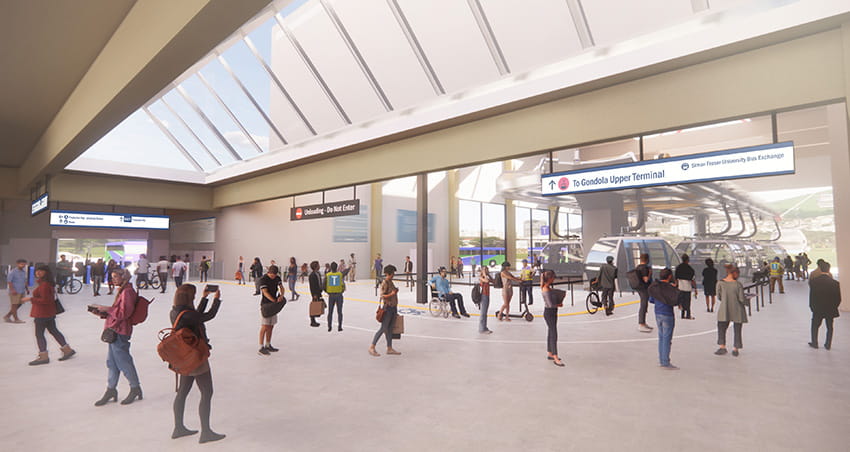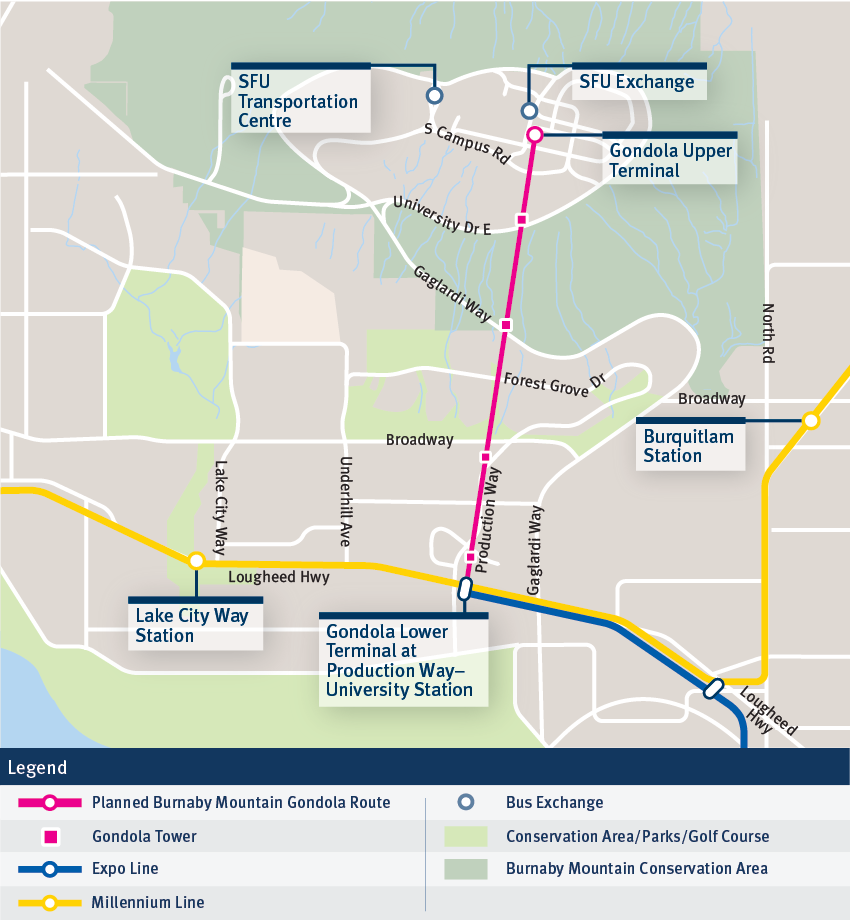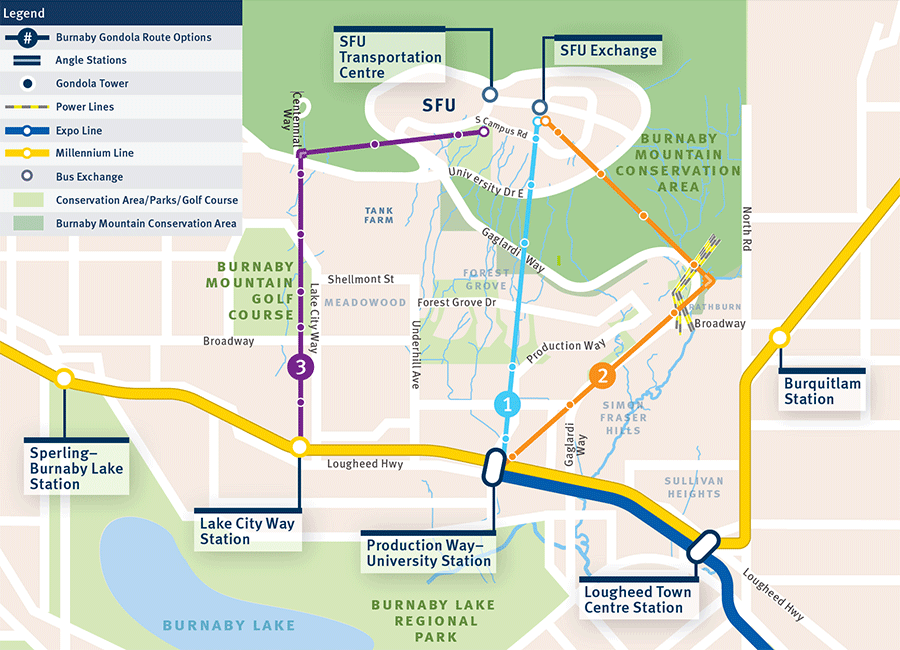Burnaby Mountain Gondola

About the Project
The Burnaby Mountain Gondola would provide a fast, frequent, and reliable service between the SkyTrain and Burnaby Mountain. A gondola offers more frequent service for our customers, can move more people per hour than other types of transportation, reduces greenhouse gases (GHGs) and other emissions, and has lower operating costs than buses.
With the gondola included in the Mayors’ 10-Year Priorities, TransLink will continue with its technical analysis as we develop a business case and will share new information with the public again in the future. We will continue working closely with the Province of BC, the City of Burnaby, Simon Fraser University, kʷikʷəƛ̓əm (Kwikwetlem First Nation), xʷməθkʷəy̓əm (Musqueam Nation), Sḵwxw̱ ú7mesh Úxwumixw (Squamish Nation) and sə̓lílwətaʔɬ (Tsleil-Waututh Nation).
A new phase of public engagement on the business case and updated technical work was completed in late 2023. For details, please read the 2023 Stakeholder and Public Engagement Summary Report and Burnaby Mountain Gondola Environmental Screening Review.
Endorsed Burnaby Mountain Gondola Route

Gondola Route Video
Watch our video to simulate what the journey could look like from Production Way-University Station to SFU from a virtual gondola cabin. The video can be rotated in 360 degrees, click/touch and hold to rotate the video in any direction.
Timeline & Engagement Details
Planning Timeline
Route evaluation and public engagement (2020-2021)
-
Undertook technical analysis of gondola systems and route options. Conducted two rounds of public engagement to share information about gondolas, the route options, criteria used to assess the routes, and to listen to stakeholder concerns and interests.
Route selection report (summer 2021)
-
A route selection report was written and shared with Burnaby Council and the Mayors' Council on Regional Transportation.
-
The result of technical work and engagement feedback led to a single, preferred route: Route 1 — the straight route from Production Way–University Station to SFU’s Burnaby campus.
Business case development (2022-2024)
-
Proceeding with technical analysis to support the business case development
-
Ongoing engagement with Indigenous Nations; future public engagement opportunities will occur.
Transport 2050: 10-Year Priorities (2022)
-
The gondola was included in TransLink’s Transport 2050: 10-Year Priorities (Now called the Access for Everyone plan).
Business Case Public Engagement (2023)
-
During the Business Case Public Engagement we shared updated technical work and asked for feedback on the project including travel and trips to and from Burnaby Mountain and the Environmental Screening Review Terms of Reference.
Investment Plan and Project Approval (Timing TBD)
-
Advancement of the business plan including Business Case Public Engagement feedback
-
For the project to proceed, it must be included in an investment plan approved by the TransLink Board and Mayors’ Council on Regional Transportation.
-
This is an upcoming stage for the project.
Potential Burnaby Mountain Gondola Routes

In 2014, the Mayors’ Council developed a 10-Year Vision for Metro Vancouver Transit and Transportation which noted that a high-capacity connection from Burnaby Mountain to a nearby SkyTrain station may be required, and that further investigation and consultation was needed.
In November 2016, the Phase One Investment Plan committed to updating a previous 2011 assessment of a gondola linking Production Way–University Station to SFU Square on Burnaby Mountain. This assessment determined that a gondola was a feasible solution for improving travel time, addressing reliability issues, meeting future travel demand, and reducing greenhouse gas emissions.
In 2017, the merits of building a gondola were re-examined and we confirmed that there is still a compelling case for a gondola transit solution. For more details, view the updated Burnaby Mountain Gondola Transit Feasibility Study.
In May 2019, Burnaby City Council endorsed a recommendation that supports a gondola link from SkyTrain to the top of Burnaby Mountain, subject to several conditions. One such condition was to include the assessment of a third route option starting from Lake City Way Station, which has been done as part of the technical work throughout 2020.
Throughout 2020, TransLink and its partners conducted a planning program with the objective of narrowing the three proposed gondola routes to a single, preferred route. The planning program included work on the conceptual design and analysis of the three routes, as well as two rounds of public engagement.
The result of the technical work and engagement feedback led to a single, preferred route: Route 1 — the straight route from Production Way–University Station to SFU’s Burnaby campus. Route 1 offers the greatest benefits, lowest costs, and lowest implementation considerations. The details of the route selection and engagement summaries can be found in the Route Selection Report (comprehensive list of Q&As included).
Details regarding historical project information can be found in the Document Library.
2023 Business Case Public Engagement
As part of the Burnaby Mountain Gondola Business Case, TransLink conducted public engagement to seek the public’s input on the project. The Business Case Public Engagement concluded on Nov. 27, 2023. We thank everyone for their participation.
Focusing on the benefits, costs, impacts, and possible risks of the gondola, below are some of the results:
-
4,504 interactions during engagement
-
Strong regional support for the project with 83% supportive (the same as the 2020 engagement, 83%)
-
43% of survey respondents were from Burnaby and strong support in Burnaby for the project (74%)
-
Majority of survey participants thought the Environmental Terms of Reference were thorough and complete (76%)
-
Majority of survey participants thought the Environmental Terms of Reference were thorough and complete (76%)
These results of the engagement will be included in the business case. Once complete, the Burnaby Mountain Gondola’s Business Case will be taken to the Mayor’s Council for their decision and direction.
2020 Public Engagement
December 2020
Between Nov. 23 and Dec. 14, 2020, the project engaged on the evaluation of the three proposed routes based on several criteria, such as the project benefits, costs, and neighbourhood, environment, and safety considerations. We shared a Preliminary Route Evaluation Report with detailed information about each of the criteria. To learn about the public feedback we received, view the Phase Two Stakeholder and Public Engagement Summary Report, or visit our Phase Two Engagement page.
September 2020
Between September 1 and 30, 2020 the project engaged on the three route options, including travel times, costs and environmental impacts, as well as neighbourhood interests. To learn about the public feedback we received, view the Phase One Stakeholder and Public Engagement Summary Report, or visit the Phase One Engagement page.
Frequently Asked Questions
Why a gondola?
For most of the year, 25,000 trips are made up and down Burnaby Mountain daily — for school, work, business, and recreation. In addition, the residential community of UniverCity has a population of roughly 7,000 residents and that number is expected to reach approximately 9,000 residents in the coming years.
Currently, passengers travelling to Burnaby Mountain often experience unpredictable travel times, with customers frequently being passed by full buses, and with the population on the mountain continuing to grow, so will the challenges.
More buses will not solve our current and future capacity problem. Our studies over the past decade have shown that a gondola service is still considered the best option for high-capacity transit to Burnaby Mountain. It would be a one-time investment to provide capacity for the next 30+ years, it would move people up the hill faster than buses, would have improved frequency and reliability, and it would extend our rapid transit network making it a more attractive option to drivers.
What are some benefits of a gondola?
Benefits of a gondola system include providing fast, frequent and reliable service. They are safe, provide ample capacity, can operate in all types of weather and use renewable energy. In addition, a Burnaby Mountain gondola would reduce greenhouse gas emissions (GHG). A gondola would reduce GHG emissions per passenger trip compared to diesel hybrid by 99%. A trip made on the gondola would have 5 g carbon dioxide emissions compared to diesel bus that would have about 400g carbon dioxide per passenger trip. It would produce 60% fewer emissions per passenger than battery electric bus. A trip made on gondola would have about 3g carbon dioxide emissions compared to about 7g for battery electric bus.
Is TransLink considering other technologies to connect Burnaby Mountain to the Skytrain?
Past studies considered a number of ground-based and aerial transit options and led to the 3S gondola technology as the preferred solution to connect Burnaby Mountain to Skytrain.
The benefits of a 3S gondola system include: the ability to operate in high wind conditions, sufficient ridership capacity, and energy efficiency, which results in lower operating costs.
We consulted with two aerial ropeway suppliers on technology options who confirmed that 3S gondola technology remains the best option.
How fast would the gondola ride be connecting SkyTrain to Burnaby Mountain?
The travel time for the gondola would be 7 minutes, compared to 15-45 minute trip by bus depending on wait times.
What is the capacity of a gondola cabin?
The maximum capacity for a gondola cabin is 30 passengers.
How frequently would each cabin depart?
During peak periods, the gondola system would operate continuously with cabins departing about every minute. In periods of low demand (i.e. early morning, midday or late evening), the frequency could be reduced to better meet demand.
How safe are gondolas?
Gondola systems are a proven safe technology with more than 20,000 ropeway systems worldwide. The proposed Burnaby Mountain Gondola would be a 3S system, which operates using three high-strength, multi-strand steel cables. This is the same system as the Peak 2 Peak gondola at Whistler Blackcomb. Gondola cabins would be stored in the terminals overnight as opposed to leaving them on the line. The system would come with strong security measures in place to monitor the integrity of the gondola, like what is in place for SkyTrain, and the towers would be designed to prevent unauthorized access.
Would all gondola cabins be accessible?
Yes, all gondola cabins would be accessible. The cabin floor would align with the terminal floor elevation and the gap between the cabin and platform would meet all requirements for safe boarding and exiting. If a passenger needs extra time to get on or off the cabin, an attendant would be present to offer assistance. If needed, the attendant could also slow or stop the system.
Would bikes be allowed on the gondola? If so, would there be any restrictions?
Yes, bikes would be allowed on the gondola. The current design assumes one bike per cabin. Helping customers make sustainable travel choices, which includes the use of bikes throughout our system, is part of TransLink’s long-term strategy. Details related to bike usage on the gondola would be determined at a later stage through passenger modelling if the project proceeds.
How many routes were assessed?
-
Option 1: A straight-line route from Production Way-University Station to SFU’s Burnaby campus with the terminal located near the bus exchange.
-
Option 2: Eastern route (with a non-boarding angle station) from Production Way-University Station to SFU Burnaby campus with the terminal near the bus exchange.
-
Option 3: Western route (with a non-boarding angle station) from Lake City Way Station to SFU’s Burnaby campus with the terminal located south of South Campus Road.
After extensive consultation, engagement, and study, option 1 was determined to be the most optimal route.
In 2011, three other routes were assessed for viability, including: Lake City Way Station to South Campus Road (across from South Sciences Building), Production Way-University Station to intersection of Highland Court and tower Road, and Burquitlam Station to SFU Bus Exchanges, These routes were not further considered as they had impacts on conservation areas and conflicts with utilities (e.g. Burnaby Mountain storage terminal).
Is property acquisition necessary if the gondola project proceeds?
Yes, property acquisition in the form of aerial passage over four multi-family property complexes is necessary to build the gondola. This means the land and homes themselves would remain untouched, but TransLink would acquire the rights for the gondola to pass over the properties in excess of the City of Burnaby’s privacy separation standard.
To acquire the necessary aerial rights, TransLink would engage the services of an independent appraiser to determine the current market value of the property/aerial rights and work to reach an agreement with each property owner.
What stage is the Burnaby Mountain Gondola at?
For the project to proceed, it must be approved by the TransLink Board and Mayors’ Council on Regional Transportation and included in an investment plan. While waiting for the next investment plan, TransLink will be advancing the business plan including feedback from the 2023 Business Case Public engagement.
